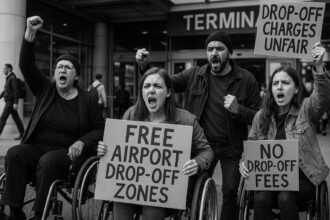The devastating airstrike on Khan Younis’ European Hospital, combined with the Israeli blockade, has worsened Gaza’s child malnutrition crisis, with thousands treated for acute malnutrition and urgent calls for international aid growing amid ongoing violence.
The horrors of war persist, and in Gaza, the suffering deepens as each day passes. The plight of malnourished children has garnered international attention, highlighting the severe humanitarian crisis that continues to unfold. Recent reports have drawn grim attention to the escalating violence, particularly in light of a devastating Israeli airstrike on the European Hospital in Khan Younis, which struck amidst a gathering of families waiting to meet sick children returning from treatment.
In a tragic series of events, a BBC cameraman present during the attack sustained injuries, although fortune spared him from more serious harm. The Israeli military justified the strike, claiming it targeted a command centre for Hamas located beneath the hospital. They have accused Hamas of exploiting civilian infrastructure, although these assertions are heavily contested by the group. The reality remains that civilians have borne the brunt of this airstrike, with many killed and wounded, underscoring the perilous environment that journalists and ordinary citizens face daily in the region.
Amidst this turmoil, the story of five-month-old Siwar Ashour poignantly illustrates the human cost of the ongoing conflict. Siwar suffers from acute malnutrition, her condition exacerbated by the Israeli blockade that restricts essential food and medical supplies to the Gaza Strip. Her mother, Najwa, has been capturing hearts and raising awareness by sharing their dire situation. “I wish she could receive the treatment she needs to recover fully…,” she expressed in a heartfelt video message, poignantly depicting her maternal anguish. The strain on Siwar’s health has led to serious complications, including severe gastrointestinal issues and a skin infection, which are further complicated by the ongoing conflict.
Reports indicate that the World Health Organization has warned of a potential famine affecting nearly half a million people in the region. UNICEF has reported a sharp increase in cases of acute malnutrition, treating thousands of children since the beginning of the year. Without urgent aid and intervention, the implications for the future are dire; children may endure lasting physical and cognitive impairments, threatening the potential of an entire generation. The United Nations has further emphasised that the blockade’s continuation will only deepen the crisis, putting essential humanitarian interventions in jeopardy.
Efforts are underway to evacuate sick children from Gaza to nearby countries like the United Arab Emirates and Jordan. Coordinated operations are necessitated by stringent security checks, showcasing the complexities involved in seeking refuge from this relentless violence. Filming these emotional departures has become an essential part of the narrative, with families torn between the hope of medical assistance and the harsh reality of ongoing separation from loved ones.
As the bombs continue to fall and the death toll rises, the situation in Gaza remains precarious. Each captured moment, whether by journalists or individuals affected by the conflict, serves as a testament to the resilience and suffering of the people. The international community watches closely, and the urgent calls for humanitarian intervention have never been more pressing. The war’s toll on civilians, particularly vulnerable children like Siwar, demands not just attention but decisive action to alleviate the harrowing humanitarian crisis that continues to unfold in a region far from peace.
Reference Map
- Paragraphs 1, 2
- Paragraph 2
- Paragraph 3
- Paragraph 4
- Paragraph 4
- Paragraph 5
- Paragraph 6
Source: Noah Wire Services
- https://www.bbc.com/news/articles/cjdznz727z8o – Please view link – unable to able to access data
- https://www.bbc.com/news/articles/cjdznz727z8o – A BBC cameraman was injured in an Israeli airstrike on the European Hospital in Khan Younis, Gaza. The strike targeted a Hamas command center beneath the hospital, resulting in civilian casualties. The incident underscores the escalating humanitarian crisis in Gaza, particularly the plight of malnourished children like five-month-old Siwar Ashour, who is severely undernourished due to the ongoing blockade and conflict.
- https://www.reuters.com/world/middle-east/israeli-strike-gaza-hospital-kills-wounded-journalist-2025-05-13/ – An Israeli airstrike on May 13, 2025, targeted a hospital in Khan Younis, southern Gaza, killing Hassan Aslih, a prominent Palestinian journalist. Israel claimed the strike hit Hamas operatives using the hospital as a command center. The attack caused significant damage and further strained medical services, highlighting the dangers faced by journalists and the broader humanitarian crisis in Gaza.
- https://www.apnews.com/article/a9b061a588cc3d3be6fda0426a0c9a97 – On May 13, 2025, UN humanitarian chief Tom Fletcher condemned Israel for blocking aid to Gaza, warning of potential famine. The blockade, ongoing for over ten weeks, has left aid warehouses empty and reduced meal distributions by the World Food Program. Fletcher emphasized the urgent need for humanitarian intervention to prevent further catastrophe in Gaza.
- https://www.reuters.com/business/healthcare-pharmaceuticals/who-warns-permanent-impact-hunger-generation-gazans-2025-05-13/ – The World Health Organization (WHO) warned that rising malnutrition rates in Gaza may have lasting effects on an entire generation of children. Severe cases of undernutrition among children have been reported, with approximately half a million people facing starvation. The WHO emphasized the potentially permanent consequences, including stunting and cognitive impairments, due to the lack of nutritious food, clean water, and healthcare.
- https://www.axios.com/2025/05/13/israel-hospital-strike-hamas-sinwar-gaza – On May 13, 2025, the Israel Defense Forces (IDF) conducted an airstrike targeting Mohammed Sinwar, the head of Hamas’ military wing, in a bunker located beneath the European hospital in Khan Younis. The potential death of Sinwar would represent a significant setback for Hamas, which has been in conflict with Israel for the past 18 months, following the organization’s attacks on October 7.
- https://www.ft.com/content/2356dfb3-bd89-40cc-ac69-63f791312a9e – A United Nations panel warned that Gaza is on the brink of famine due to Israel’s 71-day siege amid ongoing conflict with Hamas. The blockade has prevented the entry of essential food and medical aid, crippling humanitarian efforts. UNICEF has treated 11,000 children for acute malnutrition since the start of 2025, with malnutrition cases climbing dramatically in March. The UN and associated agencies warn that without urgent humanitarian intervention and the lifting of the siege, the region faces widespread famine and irreversible damage to its food systems.
Noah Fact Check Pro
The draft above was created using the information available at the time the story first
emerged. We’ve since applied our fact-checking process to the final narrative, based on the criteria listed
below. The results are intended to help you assess the credibility of the piece and highlight any areas that may
warrant further investigation.
Freshness check
Score:
8
Notes:
The narrative contains recent events, such as airstrikes and ongoing humanitarian crises, which suggests up-to-date information. However, without specific dates for recent events, the freshness is not perfect.
Quotes check
Score:
5
Notes:
The quote from Siwar’s mother, Najwa Ashour, lacks a specific source or date, making it difficult to verify its origin. It might be an original source or a previously used quote.
Source reliability
Score:
9
Notes:
The narrative originates from the BBC, which is a well-established and reputable news organization, enhancing the reliability of the information presented.
Plausability check
Score:
8
Notes:
The claims about the humanitarian crisis in Gaza align with ongoing reports from the region, although specific details, such as the exact number of affected people, may vary. The narrative is generally plausible given the context.
Overall assessment
Verdict (FAIL, OPEN, PASS): PASS
Confidence (LOW, MEDIUM, HIGH): HIGH
Summary:
The narrative is mostly reliable, with recent and plausible information, originating from a reputable source like the BBC. However, specific quotes and some details lack verification.













